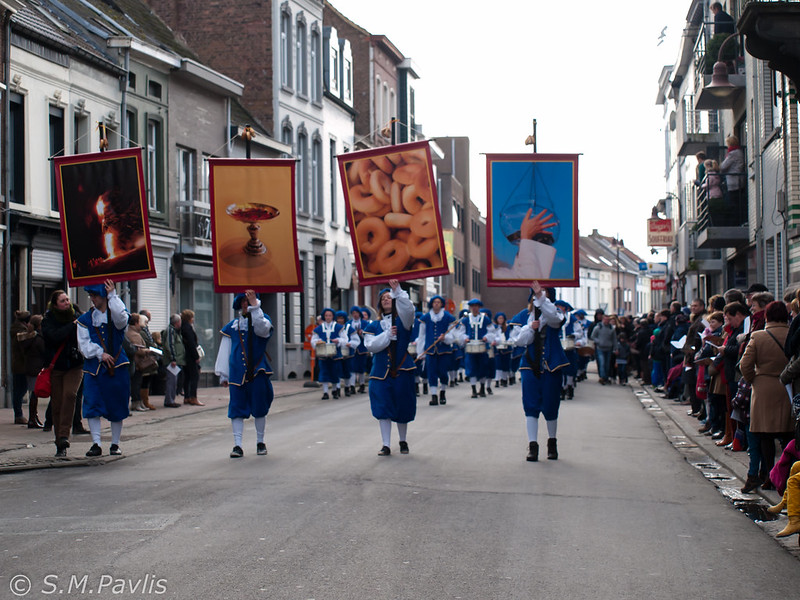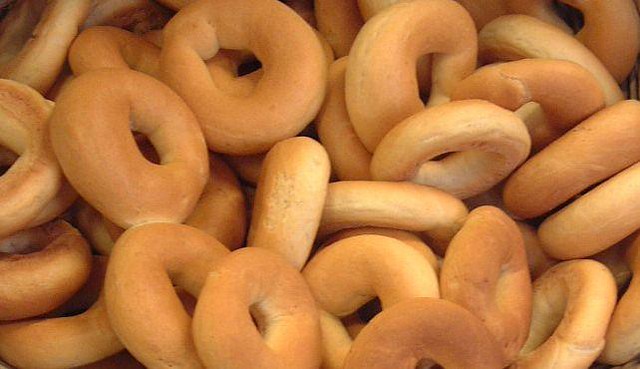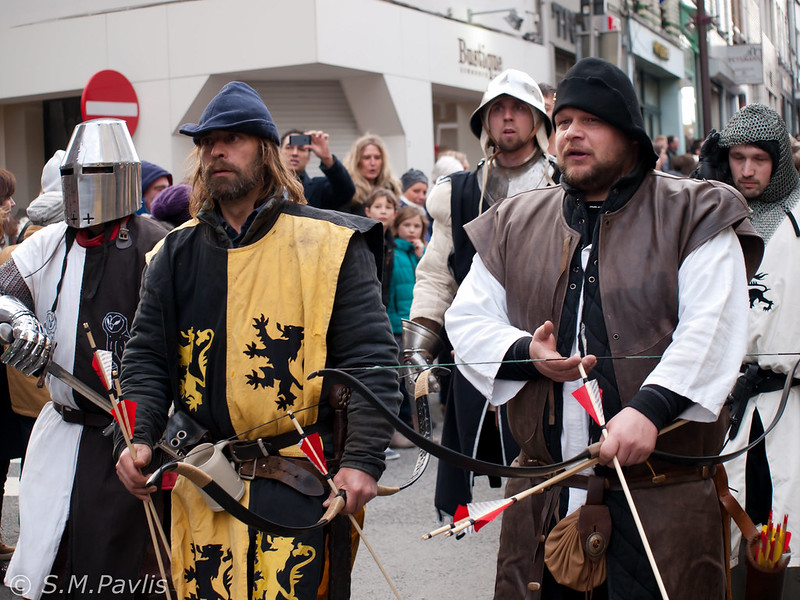Krakelingen and Tonnekensbrand
The Miracle of Geraardsbergen, Where Fire, Bread, and Ancient Prayers Envelop the Town
2026/02/28
Every year from late February to early March, the town of Geraardsbergen in Belgium comes to life with the Krakelingen and Tonnekensbrand festival. Recognized as UNESCO Intangible Cultural Heritage, this traditional event brings together bread tossing, torchlit processions, and the burning of a barrel atop the hill—blending pagan fire rituals, Christian traditions, and generations of community bonds. Whether you’re interested in history and folklore or want a festival that engages all five senses, this is truly “living folklore.”
The crackle of bonfires, the aroma of freshly baked krakelingen, the taste of sweet wine and bread, and the warmth of thousands gathered under the winter sky—on this night, ancient rituals and town pride merge, filling Geraardsbergen with light, warmth, and unforgettable memories.
Main Attractions
Krakelingen Procession
The festival begins with the Krakelingen procession. Participants dressed in historical costumes parade through the streets of Geraardsbergen, with guilds, religious figures, and legendary local characters making appearances. When the procession reaches Oudenberg hill, city officials perform the unique ritual of drinking wine with a live fish, praying for a bountiful harvest and good fortune.
Bread Toss
After the ritual, the mayor and council members toss thousands of krakelingen (hard, ring-shaped breads) from the hilltop into the crowd below. Catching one is said to bring luck for the year, and laughter, cheers, and the aroma of fresh bread fill the air.
Tonnekensbrand (Barrel Burning Fire Festival)
As night falls, the festival shifts to the top of the hill for Tonnekensbrand. A large barrel (“tonneke”) is set ablaze, illuminating the town. This fire festival, symbolizing the end of winter and the arrival of spring, is accompanied by fireworks and torch processions, bringing excitement and emotion that chase away the cold.
Costumes and Decorations
Participants wear medieval robes, religious vestments, and folk costumes, while the town is adorned with banners, torches, and traditional symbols. The rough feel of wool, the flicker of flames, and the glow of torches create a mystical and enchanting atmosphere.
Traditional Food & Drink
The star of the festival is the krakeling, a hard, ring-shaped bread with a subtle sweetness. Traditionally, it’s enjoyed with a sip of sweet wine, just as in the ritual. The aroma of freshly baked bread drifts from local bakeries, while food stalls offer sausages, stews, and mulled wine—perfect Flemish comfort food for the winter season.
Cultural and Historical Background
The origins of Krakelingen and Tonnekensbrand go back to the 10th century, when Geraardsbergen was still a small medieval settlement. At that time, to celebrate the end of winter and the arrival of spring, townspeople would light fires on Oudenberg hill, performing pagan rituals to pray for the return of the sun and a good harvest. This fire festival became the prototype for Tonnekensbrand.
By the 12th century, after periods of plague and famine, the townspeople began a ritual of sharing bread and wine while praying for divine help. This is when the tradition of the hard, ring-shaped krakeling bread and the unique custom of drinking wine with a live fish began. The bread’s ring symbolizes eternity and the cycle of life, while the fish was added as a Christian symbol.
From the Middle Ages onward, these pagan fire rituals and Christian prayer ceremonies merged, with religious processions honoring the town’s patron saint and guilds joining in, evolving into the grand festival seen today. Every year from late February to early March, the entire town celebrates the end of winter and the start of a new season—a tradition that is central to the identity of Geraardsbergen’s people.
In 2010, Krakelingen and Tonnekensbrand was inscribed on UNESCO’s Intangible Cultural Heritage list. This festival, which has continued for over a thousand years, is now recognized worldwide as a living tradition, a symbol of local pride and unity, and a vibrant piece of living history.
Participant Voices
I visited from the UK, and on the hilltop, locals shared wine and old stories with me. Watching the barrel burn against the night sky was truly mystical—I felt like I was part of an ancient ritual. Visiting the bakery early in the morning was also a highlight. The bakers told me the krakeling recipe hasn’t changed for centuries, and you can taste the history in every bite. Sharing bread with friends is what makes this festival so special.
Fun Facts
- Over 10,000 krakelingen are tossed from the hilltop each year.
- The ritual of drinking wine with a live fish is unique to Geraardsbergen and has continued for centuries.
- The burning barrel (“tonneke”) can be seen from far away and symbolizes the return of the sun.
- Krakelingen are so hard that, if kept dry, they can last for months—some families keep them as lucky charms all year round.
Festival Dates
Krakelingen and Tonnekensbrand is held annually from late February to early March in Geraardsbergen, Belgium. For the latest dates and details, check the official tourism website.
The event schedule is subject to change. Please check the official website for the most up-to-date information.
Media

photo by Erasmus en Flandes (Bélgica)

photo by Spiros Pavlis

photo by Erasmus en Flandes (Bélgica)

photo by Spiros Pavlis
Information
| Name | Krakelingen and Tonnekensbrand |
| Country | Belgium |
| Area | Geraardsbergen |
| Date | 2026/02/28 |
| Link |
Upcoming Festivals
Dia de la Virgen de Guadalupe Mexico
A Festival Weaving Faith, Fervor, and Mexican Identity
2025/12/11L'Escalade Switzerland
Geneva’s Grand Winter Festival of Courage, Chocolate, and Community
2025/12/12Umkhosi Wokweshwama South Africa
The Zulu First Fruits Festival—A Sacred Celebration of Land, Ancestors, and Renewal
2025/12/12Lucia Festival (St. Lucia's Day) Sweden
A Festival of Light Illuminating the Nordic Darkness
2025/12/15Las Posadas Mexico
The Luminous Quest for Sacred Shelter
2025/12/22Noche de Rabanos (Night of the Radishes) Mexico
A celebration blending art, farming heritage, and cultural traditions
2025/12/23Chant of the Sybil on Majorca Spain
A Medieval Prophecy Echoes Through Majorcan Christmas
2025/12/23‘Hatajo de Negritos’ and the ‘Hatajo de Pallitas’ Peru
A Christmas Festival of Rhythm, Faith, and Afro-Andean Heritage in Peru’s Ica Region
2025/12/24Harbin International Ice and Snow Sculpture Festival China
A Frozen Wonderland Where Art and Adventure Merge
2025/12/24Takanakuy Peru
The Andean Festival of Reconciliation by Fist—How Confrontation Creates Year-End Peace and Bonds